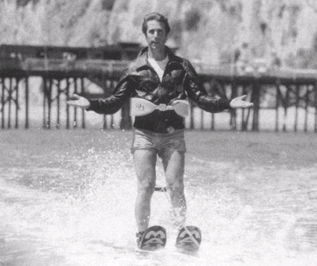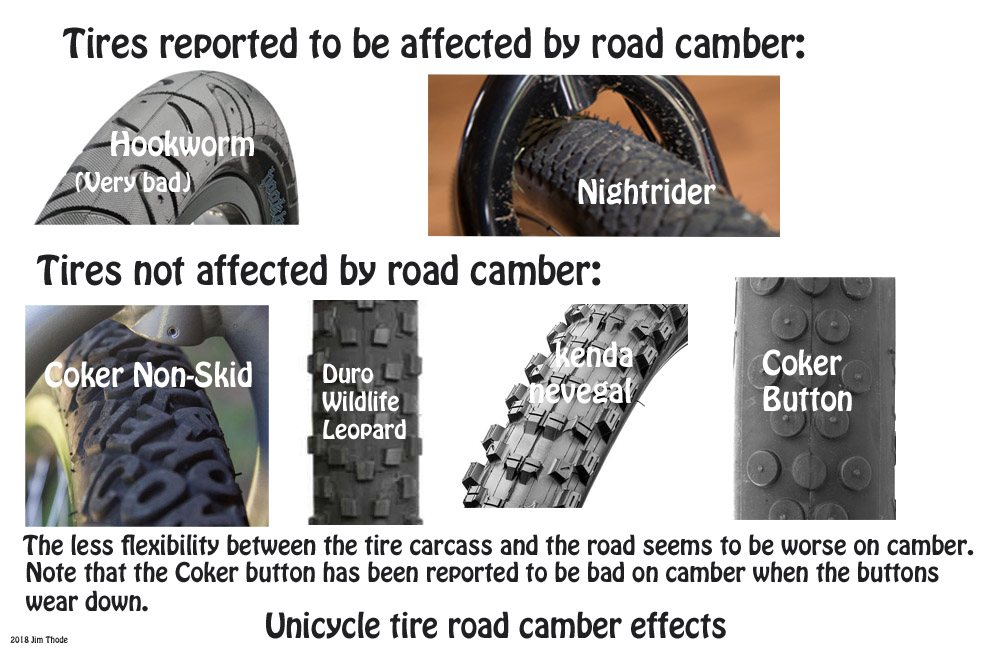Yes, there are already 75 topics in the forum where the 1st post mentions camber, and 12 of these have “camber” in their title, while at least another 8 have an extensive discussion of camber.
Maybe this new topic can become a reference for camber issues.
Of course, the simple solution is: “practice, practice, keep tire pressure up, if that fails then try another tire”.
The standard camber annoyance scenario is a long ride on the side of a paved road or track which has the rider constantly leaning toward the crown of the track (and maybe doing a bit of twisting or arm waving) to “fight” the effect of the road camber, maybe eventually causing a sore lower back or legs.
What we are “fighting” has been described in this forum as auto-steer, being turned towards (or even away from) the road center, leaning, drifting, being pushed or pulled, twisting, tilting, twitching, yawing or even squirreling.
And the tire is the culprit - with its funny geometry, flexibility, sidewalls, hysteresis and distortion of contact patch under load, especially where the wheel is not perpendicular to the road surface (i.e., the wheel is displaced from perpendicular by a camber angle).
Engineers have some insight into this. For example, Hans Pacejka has spent 30 years in related fields, and his 2005 book “Tire and vehicle dynamics” is cited by 6587 academic papers according to google scholar. You can search in the citing articles for “motorcycle”, “bicycle” or even “unicycle”, and authors like Cossalter, Sharp, Evangeloa, Lot, Dressel will appear, with information on camber related torque moments etc., as well as pneumatic trail (which is not so relevant as we have minimal tire slip).
What most of the citing authors reference is Pacejka’s “Magic Formula tyre model”. The word “magic” is disconcerting, and it is used because although the formulas are inspired by Newtonian physics - actually they are slightly ad hoc formulas with a whole bunch of coefficients that are picked to fit the experimental data. So, nobody REALLY understands the exact camber effects, but a whole lot of smart people agree on the predictions. But there is room for some variation, as even the best of the model variants for cycles merely use a uniform toroid (i.e., donut) for the tire shape (which is NOT the real shape of a Nimbus Nightrider).
I claim from my limited reading of some of these papers that their predictions are:
-
the camber effect twists unicycle + rider about a vertical axis through the tire contact point so it tends to point towards the crown of the road (if you ride on the left of the road, camber will steer you clockwise, up to the right, and if you ride on the right side of the cambered road, it will steer you anti-clockwise, up to the left).
-
the camber steer effect increases with camber angle, with tire softness (or low pressure), with tire grip, with tire width.
For what it is worth, a quote: “Twisting torque is due to fore aft shear stress distribution across the contact patch width driven by the toroidal tire shape and acts to steer the wheel into the corner in the direction of lean”.
Camber steer is less noticeable on dirt because of less tire grip, and wide knobby dirt tires may not be so bad on paved roads because of the tread having less grip than smoother road tread patterns.
The usual rider reaction is to lean your body one way (towards the road crown), then the unicycle must lean the other way to maintain balance over the contact point, which means that the wheel becomes more perpendicular to the road surface (which reduces the effective camber angle - hooray!). This body lean can be seen in many unicycle videos. Some riders may have some tricks with seat angle or handle use to minimize the annoyance on a long ride. I think most of us would agree with this observation of upper body lean.
BUT we do not all agree with “turn toward the crown” being the description of the unicycle camber steer effect. Some talented and experienced riders describe it as being pushed/pulled DOWN the camber.
This may be because highly skilled riders do so many things automatically, or maybe words are ambiguous, or…
One possible explanation of the description confusion is that there is an opposite (short term) effect when camber angle changes compared to when it is constant. For example, when a rider is on a flat path and then encounters a dip or a driveway which suddenly changes the camber. At the time of camber change, the road contact point moves sideways. E.g., if the road changes from flat to dropping away on the left side, the contact point moves to the right of the tire, causing the unicycle to be out of balance and start to lean down to the left. But as soon as we correct this, and regain balance, the normal camber effect will happen. But a good rider will predict the initial downhill lean when seeing the camber change ahead, and may usefully remember this as “a downhill camber change wants to push me downhill”, whereas with constant camber we don’t really have to predict or remember anything (just complain after a while).
Another possible explanation of the camber description confusion is that unicycle riding is not simple - we weave along in time with pedal cadence instead of going in a straight line (as assumed by the math). So, there are more physical effects to pay attention to…
It is possible that at some points in the pedaling cycle, corresponding to maximum pedal force, there is a slight rider induced extra wheel twist (maybe eventually causing uneven tire wear, by the way). This could violate the assumption that unicycles do not have a “sideslip” - they could actually have a short slip duration at 2 points in the weave, corresponding to maximum force on left and right pedals. This means they could have a small amount of “self-aligning pneumatic trail force” which would be greater at higher speeds, is subject to a short delay, and twists in the opposite direction to the camber twist discussed above for half of the weave but twists in the same direction to the camber twist for the other half of the weave. The net effect for a unicycle would still be an average camber twist towards the crown, but skilled riders probably do something with their pedaling to get a smoother ride, and in the back of their mind they sense a slight disruption to this which the front of their mind interprets as a downhill camber pull??
Another aspect of our natural weaving path is that when it is across some steep camber, such as when riding along the side of a sloping concrete drain trying to keep at the same height, there is a push from gravity which helps the downhill pointing parts of the weave but hinders the uphill pointing parts of the weave, leading to the feeling of being pulled downwards, despite the fact that the camber effect is always an uphill twist. This gravitational effect is more noticeable in “muni” play, where you seek out steep camber for fun, compared to road riding on a much smaller camber for a much longer time for which the gravity effect is negligible. But it can strongly affect your general mental association of camber with downward pull, and perhaps this explains why we cannot all agree on how to describe the camber effect?
Finally, note that there a few other camber related scenarios:
-
“camber” (i.e., roll or lean) when cornering smoothly on a flat surface, which is “good camber effect”, as twisting into the lean actually assists the turn.
-
“camber” due to inaccuracies in unicycle construction:
e.g., axle not perpendicular to frame, seat miss-aligned, dished wheel, uneven tire wear. These cause the rider to have to adjust so center of gravity is above wheel contact point, which puts the plane of the wheel at a small camber angle. -
“camber” due to rider configuration:
e.g., lateral spinal curve, leg length discrepancy, leg strength discrepancy, leg preference, so rider mass is not in line and needs lean to balance over the contact point, which puts the plane of the wheel at a small camber angle. -
“camber” due to side wind:
center of mass must be moved into the wind for balance. If rider body remains in line with frame, this causes wheel camber (as if the road was higher on windward side).
Whew, that seems a lot! Does anyone have comments or questions or arguments or camber fighting tips or extra information or issues with particular tires or anecdotes or videos to share about camber?


